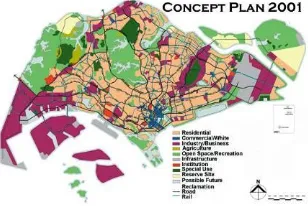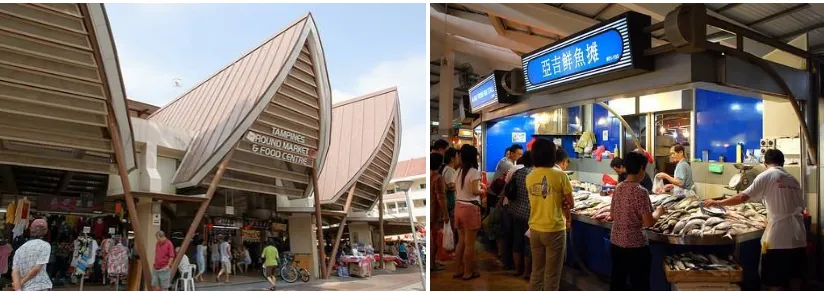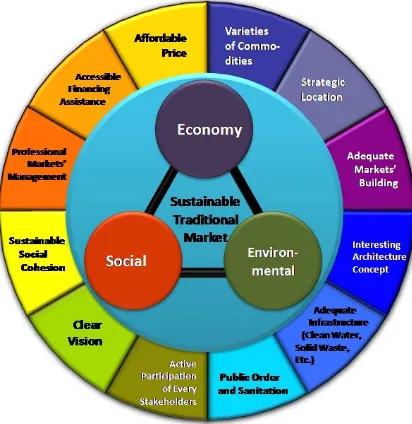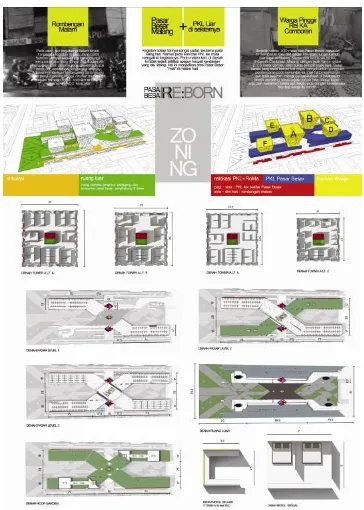Sustainable Development
Creative – Sustainable Traditional Market Design in Malang
Gunawan Tanuwidjaja
1*, Richo Wirawan
11Petra Christian University, Architecture Study Program, Jl. Siwalankerto 121-131, Surabaya, Indonesia
Abstract
Thirteen thousand four hundred and fifty (13,450) Traditional Markets in Indonesia faced great competitions from the entrants of modern markets. The traditional markets failed to compete because of poor planning, inconvenient access, overcrowded trading activities, lack of air circulation and poor sanitation, affecting 12.625 million vendors. A more sustainable development model for Indonesian traditional markets is proposed based on the Singapore’s sustainable commercial development. The Pasar Besar of Malang City, with 4,424 stores, 3,295 vendors and as one example of degrading markets, needed a new sustainable design. Therefore, an interesting architecture concept is proposed and hopefully could become an example of traditional market revitalisation in Indonesia.
Keywords: Traditional Market, Integrated Planning and Design, Creative, Pasar Besar
1.Introduction
Indonesian Traditional Markets faced great competitions from the entrants of modern markets, shopping malls etc. Indonesian traditional markets failed to compete because of poor planning, inconvenient access, overcrowded trading activities, lack of air circulation and poor sanitation [1]. And 13,450 traditional markets were dilapidated, and affecting 12.625 million vendors [2]. For example, according to PD Pasar Jaya [3] from 151 traditional markets in Jakarta, 13 markets were reported in poor condition and 111 markets were in very poor condition. And seven markets were closed due to severe competition.
Natawidjaja (2006) 4 also stated that new modern market (supermarket) sales have increased 15% per year, while the traditional market sales decreased 2% per year. Pricewaterhouse Coopers [5] also found that modern market sales would increase. The supermarket sales would increase by 50%, while hypermarket sales would grow by 70% between 2004 and 2007. This actually shows that the traditional market could not compete in the fair economic battleground with the modern market, due to many disadvantages.
Suryadarma [6 ] further described the negative impact of the severe competition. He found that informal traditional traders with the same commodity suffered the great impact of the presence of supermarkets and hypermarkets. On the other hand, fresh food traders (meat, fish, vegetables, fruit, etc.) were still able to compete with supermarkets and hypermarkets because customer preference. And the modern markets won over traditional markets because of lower prices, shopping comfort and credit-type
payment. Lastly, the modern markets established business links with large suppliers causing more efficient operation and more economies of scale.
Indonesian Government had prescribed the Presidential Decree No 112 Year 2007 for regulating the traditional and modern markets [7]. In 2014, President Jokowi, also formulated a new strategy to build or reconstruct the 5000 traditional markets in Indonesia. As stated in the Decree, Government of Indonesia is obliged to implement:
Spatial Planning and Development Control of the Traditional Markets, Shopping Centres and Modern Stores;
Regulating the supply chain to The Modern Markets (including from The Small – scale Industries); Development and Supervision of The Traditional Market (including the Empowerment Program),
Shopping Centres and Modern Markets Revitalisation of the Traditional Market.
Unfortunately, the implementation of Presidential Act No. 112 of 2007 was not effective due to [8]: Unclear classification of Traditional Markets
Uncompleted database of Traditional Markets Single-sectored approach in the implementation
Ineffective coordination between Ministry of Trade (MENDAG), Ministry of Cooperation, Small and Medium-sized Business (MENEG KUKM) and Municipal Governments
Hindrances from “status quo” party
Limited human resources capacity and funding in Government agencies, traditional markets management institutions, as well as informal traders
Lack of community participation in the process Time shortage of the project implementation
2.Literature Review
To propose a more sustainable development model for Indonesian traditional markets, Singapore case study was evaluated. The Singapore’s sustainable commercial development, in the 40-years period, showed the successful integrative planning, design and management effort.
Singapore became a strong economic country-state capitalising on its commercial development for the international market demand [9]. With annual growth of 2-10% and Gross National Income (GNI) $ 363,827.2M, in 2013 the city has proven its resourcefulness to become “the Global City” [10]. The revolution of Singapore was started by Ministry of National Development (MND) and Urban Redevelopment Authority (URA) as the Urban Planning Authority [11]. Since then, the integrated urban and economic - planning and development were conducted with Economic Development Board (EDB), Singapore Tourism Board (STB), Housing Development Board (HDB), etc. And this creative collaboration resulted in “Sustainable Urban Development” [12].
translated into Master Plan 2003. The Master Plan was used as the detailed guide for the city development for the next 10-15 years [14].
Figure 1. The Ring Concept Plan in 2001, Source: Urban Redevelopment Authority of Singapore, http://www.ura.gov.sg
Figure 2. The Concept Plan 2001, Source: Urban Redevelopment Authority of Singapore, http://www.ura.gov.sg
Discussing the Commercial Planning, Singapore Creative Collaboration was implemented with several strategies. First, the rational commercial planning was conducted by URA in the Concept and Master Plan.
Table 1. Commercial Typology of Singapore, Source: Urban Redevelopment Authority of Singapore, http://www.ura.gov.sg
No Commercial
Centres
Average Catchment Radius (km)
Average Catchment Area
(ha)
Catchment Population (Person)
Catchment Population (Density Unit) or
Up to
1 Metropolitan Serving National Population
2 Regional Centres 5 14.000 500.000 166.667
3 Sub-regional Centres Type 1 3 3.000 200.000 66.667
4 Town Centres (TC)
Type 1 1.5 700 20.000 60.000
5 Neighbourhood
Centres (NC) Type 1 0.4 50 2.000 6.000
6 Amenity Centre 0.5 50 15.000 5.000
Table 2. Detail of Commercial Typology of Singapore Source: Urban Redevelopment Authority of Singapore, http://www.ura.gov.sg
No Commercial
Centres
Gross Commercial Floor Area (sqm) approximation only
Office Retail
Entertain-ment Hotel Total
1 Metropolitan 7.000.000 5.000.000 3.000.000 15.000.000 2 Regional Centres 800.000 400.000 20.000 200.000 1.420.000
3 Sub-regional
Centres Type 1 61.000 178.000 89.000 328.000
4 TC Type 1 39.000 34.000 13.000 0 86.000
5 NC Type 1 - 8.000 0 0 8.000
Following the rational commercial planning, URA allocated strategic areas in Central Region for Commercial Areas or Shopping Streets with proper planning; careful design; as well as constant monitoring of commercial spaces intake and prices [15].
Due to those positive data in 1970-2000’s, URA was confident to allow more area for commercial development. And URA conducted the Government Land Sale program (GLS) via public tender for commercial. Then, the private sector could contribute in the developing innovative commercial ideas [16]. The URA’s Development Control Division has to evaluate and approve the projects. URA also ensures the infrastructure provision, environmental improvements and building construction standards with other agencies [17].
Secondly, URA prescribed a new Commercial Area serving a New Town, normally in its central and close to MRT or Bus Station. One of successful example of the Regional Commercial Centre is Tampines which complemented with sizeable commercial area [ 18 ]. Thirdly, the strategy of historical areas revitalization for commercial areas was adopted. This strategy was successful with increasing number of foreign tourists and local shoppers in areas such as Kampong Glam, Chinatown, Kampong Bugis, Little India, Joo Chiat, etc.
Loo et. all. [19] found that most of the town centres were sustainable. But some neighbourhood centres were lacked of vitality because of growing affluence and increased mobility of the residents. This indicated that the retail hierarchy need the rationalisation following current economic trend.
The Government also introduced resettlement of street hawkers since 1971. The program actually catered basic stall facilities and services such as piped potable water, electricity and garbage collection and disposal. And it was reported that by 1996, all street hawkers had been resettled. Most of the food centres and traditional markets were located in the Town Centres and the Neighbourhood Centres. Some excellent examples were presented below [20].
3.Results and Analysis
On the other hand, sustainable commercial development in medium-sized cities such as Malang, need more attention from the Government. Malang is the second largest city and the educational hub of East Java Province, Indonesia. The city’s population is 820,243 persons and average annual population growth rate 0.80% [21].
It is a popular destination for Surabaya and surrounding cities residents because of its cool temperature. And it is a thriving city, with steady economic and population growth and not affected by the Asian financial crisis [22].
Badan Pusat Statistik Kota Malang [23] highlighted the Gross Regional Domestic Product of Malang with total of Rp. 30,802,611,880. The City Regional domestic product was mostly contributed by Commercial, Hotel and Restaurants sector (38.06%), Industry (33.48%) and Services (12.42%). Traditional and modern markets which could be categorised under trades actually contributed almost 28.23% or Rp. 8,696,893,057. And this is very substantial for
Table 3. Percentage Distribution of Gross Regional Domestic Product at Current Market Price Source: Badan Pusat Statistik Kota Malang (2011)
No Sectors Percentage Distribution of Gross Regional
Domestic Product at Current Market Price
1 Agriculture 0.37%
2 Mining and Quarrying 0.03%
3 Industry 33.48%
4 Electricity, Gas and Clean Water 1.40%
5 Construction 3.14%
6 Trade, Hotel and Restaurant 38.06%
6a Major and Retail Trading 28.23%
6b Hotel 0.48%
6c Restaurant 9.34%
7 Transportation and Coomunication 3.01%
8 Financial, Rental and Coorporate Services 8.11%
9 Services 12.42%
The Malang City area of 110.06 sq. km is divided into five districts, such as: Kedungkandang, Sukun, Klojen, Blimbing and Lowokwaru. Agriculture sector is the main sector, except Klojen sub-district. The Malang City produced 13,629 tonnes anually from 2,090 Ha rice field. Meanwhile, it also produced 1,174 tonnes of corns, 243 tonnes of cassavas and 29 tonnes of sweet potatoes. The plantation sector of Malang produced a great volume of fruits anually such as: Avocado (1,557 tonnes), Durian (308 tonnes), Rose Apple (580 tonnes), Orange (2,259 tonnes), Mango (4,046 tonnes). Papaya (3,739 tonnes). Banana (8,894 tonnes), Rambutan (2, 243 tonnes), Zalacca (10,206 tonnes), Star Fruit (1,872 tonnes) and Jackfruit (1,549 tonnes). Therefore, traditional markets for agriculture products played important roles in the city development [24].
Table 4. Distribution of Markets in Malang City by Sub-Districts Source: Badan Pusat Statistik Kota Malang (2011)
No Sub-Districts Classification of the Market Total
I II III IV V Total
No Name of unhealthy. In 2013, revenue from traditional markets reached USD 3.2 billion. Therefore, Malang Municipality would revitalize the 14 traditional markets to change the negative image of traditional markets. Revitalization of traditional markets required budget of Rp 41.5 billion. To facilitate existing traders to be able to utilise the revitalised markets, a participatory revitalisation strategy must be proposed [25].
Understanding the importance of Traditional Market in Malang, a new strategy was proposed with creative integrated planning and design based on Singapore case study. The strategy could be described below:
Developing Web-GIS-Based Database of Traditional Markets, Shopping Centres and Modern Stores (with Collaboration of all Stakeholders)
Regulating the supply chain to The Modern Markets (including from The Small – scale Industries) Spatial Planning and Development Control of the Traditional Markets, Shopping Centres and Modern Stores (with Collaboration of all Stakeholders)
Development and Supervision of The Traditional Market (including the Empowerment Program), Shopping Centres and Modern Markets
Revitalisation of the Traditional Market (with Community Based Empowerment) Program Evaluation (with all stakeholders)
And all these steps needs to be developed in collaboration of all Stakeholders, such as Ministry of Trade, Ministry of Industry, Ministry of Cooperatives and SMEs, Ministry of Internal Affairs, Ministry of Public Works (especially The Spatial Planning Directorate), Ministry of Marine Affairs and Fisheries, Ministry of Health, Indonesia Investment Coordinating Board (BKPM), Commission for the Supervision of Business Competition (KPPU), Central Bureau of Statistics, Municipal Governments & Local Agencies, Association of Traditional Markets Management Indonesia (ASPARINDO), Association of Traditional Markets’ Traders Indonesia (APPSI), Association of Shopping Centres of Indonesia (APPBI), Suppliers and Local Communities of the Markets. 26
Firstly, Web-GIS Based Database of Traditional Markets, Shopping Centres and Modern Stores is proposed to support the decision making process as well as monitoring and evaluation of the program.
modern market development. Public workshops should be conducted to integrate all stakeholders input in the spatial plans and the field implementation.
Lastly, Participatory-Traditional Market Revitalisation of should be conducted to ensure the sustainability of the traditional markets. The rationale of this step is to achieve the Sustainable Commercials and to give win-win solution. This process required continuous effort and collaboration of all stakeholders. And it could be done with:
Program Introduction Visioning
Stakeholders Workshops (regular in every stages) Market Study
Participatory Mapping (internal) Cost Benefit Analysis
Preparing Business Plan (including the Stakeholders Involvement) Participatory Planning and Design
Temporary Resettlement and Compensation Detailed Engineering Design (DED)
Development Control (Building and Infrastructure) Building and Infrastructure Construction
Participatory Management
Participatory Monitoring and Evaluation.
Figure 4. The Sustainable Market Concept for Indonesia
and Sanitation, Active Participation of Every Stakeholders, Sustainable Social Cohesion, Professional Markets’ Management, Accessible Financing Assistance for Traders and Buyers.
Pasar Besar as the biggest traditional market in Malang, with 4,424 stores and 3,295 vendors, had the largest trading volume in Malang. The Pasar Besar is located in the Chinatown area, with many Dutch Architecture influence. On the other hand, the current Pasar Besar was not built with conservation approach, leaving the building unmanaged. The Pasar Besar actually provided wide ranges of products such as food, clothing, paintings, electronics, toys, snacks and drinks.
Therefore, a new concept of Pasar Besar: Reborn with modern and efficient was proposed. The traditional market blocks are going to be rearranged dynamicly. The traditional market is design with slim masses allowing daylighting to all trading floors. The market is rearranged to several zones allowing better functional performance and easier shopping process. The new zones are dry market, wet market, clothing and textiles, electronics, jewellery, second-hand or antique products. Off course, some new achors tenant and foodcourt also will be proposed to attract more visitors to the higher level of the markets.
Furthermore, six (6) low-cost apartment towers are provided for the low-income community in Malang. To facilitate the social interaction in the city as well as the local residents, a public space is proposed in the rooftop of traditional markets. This will also increase the visitor numbers of the traditional markets. Lastly, the concept was already proposed to Nippon Paint Young Designer Award 2014.
Figure 7. The Pasar Besar Revitalisation Concept Figure 8. The Pasar Besar Revitalisation Concept
4.Conclusion
Traditional Markets needed greater concentration from the current Indonesian Government, because possesing important roles in the economic, social as well as environmental sectors. The Pasar Besar, the largest traditional market in Malang needed a new sustainable market concept. Therefore, an Interesting Architecture Concept is proposed. The concept hopefully could become an example of traditional market revitalisation in Indonesia.
References
[1] Natawidjaja, R. S., ‘Modern Market Growth and the Changing Map of the Retail Food Sector in Indonesia.’ Pacific Food System Outlook 9th Annual Forecasters, 2006, [online] <http://www.pecc.org/food/papers/2005-2006/Indonesia /indonesia-paper. pdf> [6 July 2006]
[2] Asosiasi Pemerintah Kabupaten Seluruh Indonesia (APKASI) : Badan Kerjasama Kabupaten Seluruh Indonesia (BKKSI), (2003), Profil kabupaten di Indonesia [translated in English, Association of District Government of Indonesia (APKASI): Indonesian Regency Cooperation Agency (BKKSI), (2003), Profile districts in Indonesia]
[3] http://www.jakarta.go.id/en/pemerintahan/perusahaan_pemda/pasar_jaya/pasar3a.htm [4] Op.cit. 1.
[5] Pricewaterhouse Coopers, Global Retail and Consumer Study From Beijing to Budapest, 2005 [online] <http://www.pwc.com/gx/eng/about/ind/retail/growth/ indonesia.pdf> [6 July 2006]
[6] Suryadarma, D., et al, ‘The Impact of Supermarkets on Traditional Markets and Retailers in Indonesia’s Urban Centers.’ Research Report. Jakarta: The SMERU Research Institute, 2005.
[8]
http://www.castleasia.com/Opinion/IND-ENG-Perpres%20112-2007%20Penataan%20&%20Pembinaan%20Pasar%20Tradisional,%20Pusat%20Perbelanjaan%20&%20Toko%20Modern%2 0(ABNR).pdf
[9] Yuen, B., Singapore Housing: A Strategy for Urban Development and Regeneration, The City Region in a World of Globalisation: Urban Strategies for Sustainable Development Conference, in Bergen Norway, 18 – 22 June 2000., 2000, Source: http://publications.ksu.edu.sa
Dale, O.J. Urban Planning in Singapore The Transformation of a City, Oxford University Press, 1999. [10] Singapore Department of Statistics, Yearbook of Statistics Singapore 20013, 2013, accessed in:
http://www.singstat.gov.sg/docs/default-source/default-document-library/publications/publications_and_papers/reference/yearbook_2014/yos2014.pdf
[11] DBJ Report, Building A 21st Century City, Optimizing Land Resources and Nurturing A Garden Within A City, March 2004, Development Bank of Japan, Representative Office in Singapore, 2004, accessed in: www.dbj.go.jp
Ministry of National Development, Building a 21st Century City, 2011. Accessed in: http://www.mnd.gov.sg, Urban Redevelopment Authority of Singapore, http://www.ura.gov.sg
Dale, O.J. Urban Planning in Singapore The Transformation of a City, Oxford University Press, 1999. [12] Urban Redevelopment Authority of Singapore, http://www.ura.gov.sg
Wong T-C., Yuen B., and Goldblum C. (Eds.), Spatial Planning for a Sustainable Singapore, Springer in Association with the Singapore Institute of Planners. Singapore, 2008.
[19] Loo-L.S., Shi-M.Y. , Malone-Lee L.C., Re-examining the retail hierarchy in Singapore: Are the town centres and
neighbourhood centres sustainable?, Journal Town Planning Review, Issue Volume 73, Number 1 / March 200, Pages 63-81, Liverpool University Press, 2000.
[20] Loo-L.S., Restructuring the small-scale retail sector in Singapore, Journal: International Journal of Retail & Distribution Management, Volume 27, Issue 2, Page 83 – 91, Emerald Group Publishing Limited. 1999,
http://streetnet.org.za/english/ASIANHAWKERS.pdf
Medina-Pizzali, A.F. Low Cost Fish Retailing Equipment and Facilities in Large Urban Areas of South East Asia, FAO Fisheries Technical Paper No 405, FAO, Rome 2001. 2001, Accessed in: http://www.fao/org/DOCREP/005/y2258E.htm [21] Badan Pusat Statistik Kota Malang (BPS Kota Malang), Kota Malang dalam Angka 2011, 2011. [ translated in English:
Statistics Bureau of Malang City, Malang City in Figures 2011, 2011].
[22] Graham, D., 'Malang: Not an unfortunate city', The Jakarta Post, 17 February 2013, 2013. [23] Op.cit.21
[24] Op.cit.21
[25] Widianto, E.,Empat Belas Pasar Tradisional di Malang Kumuh dan Tak Sehat, Koran Tempo, Jum’at, 07 February 2014, 2014. [translated Widianto, E., 14 Traditional Markets in Malang is Improper and Unhealthy, Tempo Paper, Friday, 07th February 2014, 2014]. Accessed in:
http://www.tempo.co/read/news/2014/02/07/058552145/14-Pasar-Tradisional-di-Malang-Kumuh-1 Natawidjaja, Ronnie S. (2006 ) ‘M odern M ar ket Growth and the Changing M ap of the Retail Fo od Sector in Indones ia.’ Pacific Food Sys tem Outlook 9th Annual Forecas ters [online] <http: //www.pecc.org/ food/papers /2005 -2006/ Indones ia /indones ia-paper. pd f> [6 J uly 2006] 2 As os ias i Pemerintah Kabupaten Seluruh Indones ia (APKA SI) : Badan Kerjas ama Kabupaten Seluruh Indones ia (BKKSI ), (200 3), P rofi l kabupaten di In dones ia [trans lated in Englis h, As s ociation of Dis t rict Governmen t of I ndones ia (APKAS I): Indones ian Regency Cooperation Agency (BKKS I), (2003), Pro file dis tricts in Indones ia] 3 http://www.jakar ta.go.id/en/peme rintahan/perus ahaan_pemda/pas ar_jaya/pas ar3a.htm
4 Natawidjaja, Ronnie S. (2006 ) ‘M odern M ar ket Growth and the Changing M ap of the Retail Fo od Sector in Indones ia.’ Pacific Food Sys tem Outlook 9th Annual Forecas ters [online] <http: //www.pecc.org/ food/papers /2005 -2006/ Indones ia /indones ia-paper. pd f> [6 J uly 2006] 5 Pricewaterhous e Coopers (2005 ) Global Retail and Cons umer Study F rom Beijing to Budapes t [online] <http: //www.pwc.com/gx/en g/about/ind /retail/g rowth/ i ndones ia.pdf> [6 J uly 2006]
6 Suryadarma, Daniel et al (2005 ) ‘ The Impact o f Super markets on T raditional M arkets and Retailers in Indones ia’s Urban Centers .’ Res earch Report. J akarta: T he SM ERU Res earch Ins titute 7 http://www.bpkp. go.id/uni t/hukum/pe rpres /2007/11 2-07.pd f
8 http://www.cas tleas ia.com/Opinion/ IND- ENG-Pe rpres %20112 -2007 %20Penataan%20 &%20 Pembinaan%20 Pas ar%20 Tradis ional, %20Pus at%20 Perbelanjaan%2 0&%20 Toko %20M odern% 20(ABNR).pd f 9 Yuen, B., (2000), Singapore Hous ing: A Strategy for U rban Development and Regeneratio n, The City Reg ion in a Wor ld of Global is ation: Ur ban Str ategies for Sus tainable Development Confer ence, in Bergen Norway, 18 – 22 J une 2000. So urce: http: //publicatio ns .ks u.edu.s a Ole J ohan Dale (1999)., Urban Planning i n Singapo re The Trans for mation of a Cit y, Oxfo rd Univers ity Pres s .
10 Singapore Depart ment of Statis tics (2013), Yearbook of Statis tics Singapo re 20013, http ://www.s ings tat.gov.s g/docs /default -s ource/default -document- libra ry/publicatio ns /publications _and_papers /refe rence/yearbook_2014 /yos 2014.pdf 11 DBJ Report (2004), Buildi ng A 21s t Century City, O ptimizing Land Res ources and Nurtur ing A Garden With in A City, M arch 2004, Develop ment Bank of J apan, Repres entative Office in Singapo re, s ource: www.dbj.go.jp M inis try of National Develop ment, http: //www.mnd.go v.s g,
M inis try of National Develop ment (2001 ), Buildin g a 21s t Century City, Urban Redevelopment Author ity of Singapore, h ttp://www.u ra.gov.s g Ole J ohan Dale (1999)., Urban Planning i n Singapo re The Trans for mation of a Cit y, Oxfo rd Univers ity Pres s . 12 Urban Redevelopment Author ity of Singapore, h ttp://www. ura.gov.s g
Wong T-C., Yuen B., and Goldb lum C. ( Eds .) (2 008), S patial Planni ng fo r a Sus tainable Singapo re, Spr inger in As s ociation with the Singapo re Ins titute o f Planners . Singapore 13 Urban Redevelopment Author ity of Singapore, h ttp://www. ura.gov.s g
14 Urban Redevelopment Author ity of Singapore, h ttp://www. ura.gov.s g 15 Urban Redevelopment Author ity of Singapore, h ttp://www. ura.gov.s g
16 DBJ Report (2004), Buildi ng A 21s t Century City, O ptimizing Land Res ources and Nurtur ing A Garden With in A City, M arch 2004, Develop ment Bank of J apan, Repres entative Office in Singapo re, s ource: www.dbj.go.jp M inis try of National Develop ment, http: //www.mnd.go v.s g,
M inis try of National Develop ment (2001 ), Buildin g a 21s t Century City, Urban Redevelopment Author ity of Singapore, h ttp://www.u ra.gov.s g
17 DBJ Report (2004), Buildi ng A 21s t Century City, O ptimizing Land Res ources and Nurtur ing A Garden With in A City, M arch 2004, Develop ment Bank of J apan, Repres entative Office in Singapo re, s ource: www.dbj.go.jp M inis try of National Develop ment, http: //www.mnd.go v.s g,
M inis try of National Develop ment (2001 ), Buildin g a 21s t Century City, Urban Redevelopment Author ity of Singapore, h ttp://www.u ra.gov.s g 18 Urban Redevelopment Author ity of Singapore, h ttp://www. ura.gov.s g
19 Loo- Lee Sim, Shi-M ing Yu , Lai-Choo M alone -Lee (200 2), Re-examini ng the retail hierarchy in Singapo re: Are the town cent res and neighbourhood centres s us tainable?, J ournal Town Plann ing Review, Is s ue Volume 73, Number 1 / M arch 200, Pages 63-8 1, Live rpool Unive rs ity Pres s .





